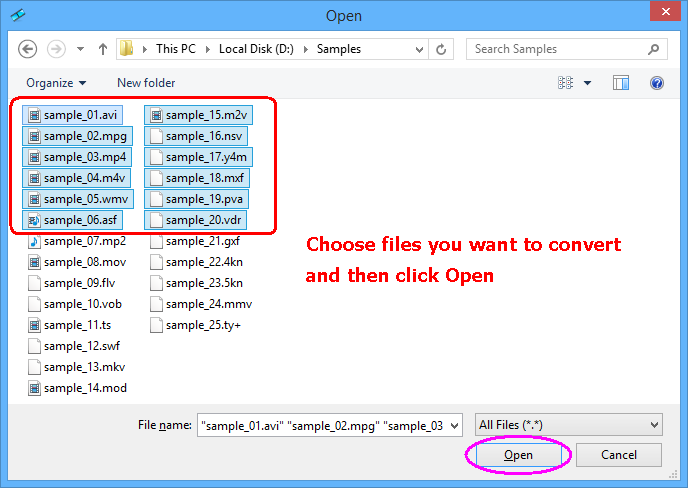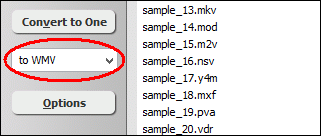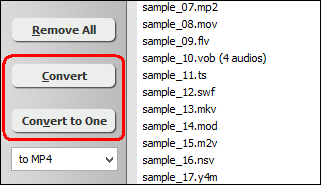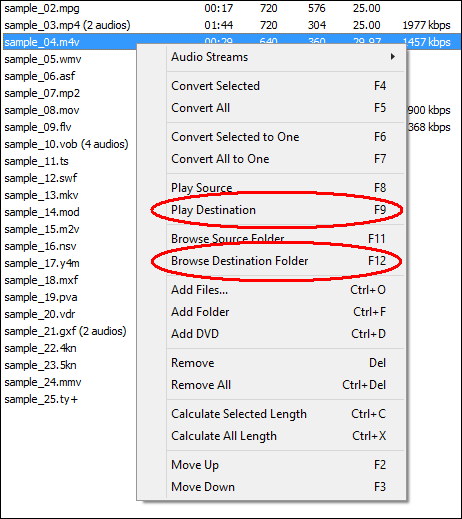 |
Convert MVI to WMV
|
MVI to WMV Conversion Software converts MVI files to WMV.
The software is an easy to use and professional video converter. MVI
to WMV Conversion Software could choose the best fit bit rate automatically when
converting file, so that the converter will keep original video and audio quality.
And, size of outputted file is acceptable. You could also customize video size,
frame rate, and bit rate. The software also supports common file format such as
3G2, iPod touch, OGV, ASF, AVI, PS3, H.264, DV, etc. It could convert Y4M to Zune, 3GPP to DivX, EVO to VCD, VOB to WebM, RMVB to OGV, EVO to Xvid, and so on.
MVI to WMV Conversion Software supports batch conversion
that enables you convert bulk MVI files to WMV at a time. The software is
full compatible with 32-bit and 64-bit Windows 10/8/7/Vista/XP/2000.

What is MVI?
Motion Pixels version 1 (MVI1) was used in a single PC game, Treasure Quest
while version 2 (MVI2) was used in a number of Movie CDs. All of these items were
published by Sirius Publishing and the Motion Pixels codec is believed to still
be owned by the company's CEO, Richard Gnant.
MVI belongs to the "old-school" family of video codecs and relies
on interframe differences and adaptive delta-coding for horizontal lines of the
picture. Delta coefficients are additionally Huffman-packed. For better compression
at the cost of picture quality additional colorspace downsampling may be used.
MVI2 adds smoother delta-coding and the ability to dynamically change downsampling
for each frame.
Compressed MVI1 video may be carried in the custom MVI Container format.
What is WMV?
Windows Media Video (WMV) is a compressed video file format for several proprietary
codecs developed by Microsoft. The original codec, known as WMV, was originally
designed for Internet streaming applications, as a competitor to RealVideo. The
other codecs, such as WMV Screen and WMV Image, cater for specialized content.
Through standardization from the Society of Motion Picture and Television Engineers
(SMPTE), WMV has gained adoption for physical-delivery formats such as HD DVD
and Blu-ray Disc.
A WMV file is in most circumstances encapsulated in the Advanced Systems Format
(ASF) container format. The file extension .WMV typically describes ASF files
that use Windows Media Video codecs. The audio codec used in conjunction with
Windows Media Video is typically some version of Windows Media Audio, or in rarer
cases, the deprecated Sipro ACELP.net audio codec. Microsoft recommends that ASF
files containing non-Windows Media codecs use the generic .ASF file extension.
The ASF container can optionally support digital rights management using a
combination of elliptic curve cryptography key exchange, DES block cipher, a custom
block cipher, RC4 stream cipher and the SHA-1 hashing function.
Although WMV is generally packed into the ASF container format, it can also
be put into the AVI or Matroska container format. The resulting files have the
.AVI and .MKV file extensions, respectively. WMV can be stored in an AVI file
when using the WMV 9 Video Compression Manager (VCM) codec implementation. Another
common way to store WMV in an AVI file is to use the VirtualDub encoder.
Windows Media Video (WMV) is the most recognized video format within the WMV
family. Usage of the term WMV often refers to the Microsoft Windows Media Video
codec only. Its main competitors are MPEG-4 AVC, AVS, RealVideo, DivX, and Xvid.
The first version of the codec, WMV 7, was introduced in 1999, and was built upon
Microsoft's implementation of MPEG-4 Part 2. Continued proprietary development
led to newer versions of the codec, but the bit stream syntax was not frozen until
WMV 9. While all versions of WMV support variable bit rate, average bit rate,
and constant bit rate, WMV 9 introduced several important features including native
support for interlaced video, non-square pixels, and frame interpolation. WMV
9 also introduced a new profile titled Windows Media Video 9 Professional, which
is activated automatically whenever the video resolution exceeds 300,000 pixels
(e.g., 528x576, 640x480 or 768x432 and beyond) and the bitrate 1000 kbit/s. It
is targeted towards high-definition video content, at resolutions such as 720p
and 1080p.
How to Convert MVI to WMV?
- Free Download
MVI to WMV Conversion Software
- Install the software by instructions
- Launch MVI to WMV Conversion Software
- Choose MVI Files

Click "Add Files" to choose MVI files and then add them
to conversion list.

Choose one or more MVI files you want to convert and then click Open.
- Choose "to WMV"

- Convert MVI to WMV

Click on "Convert" to convert MVI files to WMV format; alternatively,
click on "Convert to One" to convert all files in list and
combine to a single one WMV file.

The software is converting MVI files to WMV format.
- Play and Browse WMV File

When conversion completes, you could right-click on converted file and choose
"Play Destination" to play the outputted WMV file; or choose "Browse
Destination Folder" to open Windows Explorer to browse the WMV file.
Top
MVI to WMV Conversion Software is 100% clean and safe to
install. It's certified by major download sites.

MVI to WMV Related Topics:
|

